I donít know why but it seems like thereís
been a number of safety notices from various manufacturers in the shooting
industry. The latest is from Hodgdon. As you know, they publish a booklet type
annual reloading manual. Turns out in the 2004 edition there is a mistake on
page 132. The data listed for the 45 Long Colt with 250 grain Hornady XTP and
300 grain bullet with Hodgdon's Long Shot powder is intended for Freedom Arms,
Ruger, and T/Cs only. Use of those loads in a regular Colt or a reproduction
Colt "could result in severe personal injury (including death) or gun damage to
the user or bystander".
Boy, thatís
the first time Iíve ever heard a manufacturer say the "D" word i.e. death. So if
you have the 2004 annual manual or plan to pick one up, get a fat black magic
marker and cross out that data.
Actually, the 45 Long Colt isnít really
that bad a cartridge for silhouette. A modest charge under that big fat bullet
is really a ram buster. Several years ago my friend Hulan Mathies took the NRA
nationals in revolver by shooting a Dan Wesson in 45 Long Colt. So, the old Colt
cartridge can be very accurate as well. Might be fun to try out.
New Products from Hoppes
Hoppes, the most famous people in firearms cleaning products, has a
couple of new things this year. The item that I really like the best is itís new
graphite cleaning rod. This is a 36" rod with a plastic bore guide that actually
fits into the action of my XP-100. The biggest advantage of the graphite rods is
the fact that theyíre solid graphite all the way through. Unlike coated rods, if
you scratch them, youíre not exposing bare metal underneath. Iíve got a couple
of coated rods that are really scrapped up. Thatís never going to happen with my
Hoppes rod.
The main thing however is the fact that a graphite rod is never, ever,
going to damage the rifling lands in your gun. The graphite is not a hard
material and itís also fairly slick. Make sure to give the rod a wipe with a
paper towel now and then when cleaning your gun to make sure its not picking up
grit on its surface.
Another nice thing is the fact that the rod is very light in weight. I
donít know, but as a result, it just seems easier to maneuver. Additionally,
when I have a tight patch on, the rod really does rotate with the rifling. My
coated rods usually donít, and the patch just slips over the top of the rifling.
These rods are more expensive, but unless something really drastic happens, they
ought to last a life time.
Hoppeís also has a new "Elite" line of bore cleaners. The Elite Field
Cleaner is an all purpose CLP (cleaner, lube, and protectant) type. The other is
the Elite Gun Cleaner which is more geared toward heavy duty cleaning. I tried
both on a TC barrel that I have that is a real copper fouler. The Field Cleaner
did a good job of getting rid of the carbon and most of the copper, however it
was the Gun Cleaner that did the best job of getting everything out. Hoppes
claims that the Gun Cleaner will clean a barrel to a level that is even better
than its original finish. I canít verify that statement but it does a very good
job of cleaning up leading and copper fouling.
|
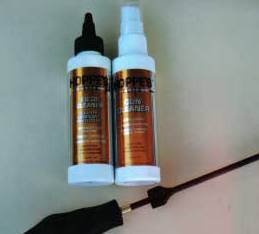
|
|
"New Hoppes bore
cleaners provide the shooter good performance and the graphite cleaning
rod is one of the very best." |
|
The icing on the cake is that both of these products are nontoxic,
nonflammable, and biodegradable. The nontoxic part might be important to some. A
well known gun writer from several years ago unfortunately developed and
subsequently died of cancer. In one of his last published articles, he squarely
laid the blame for his disease against the chemicals used in a very popular bore
cleaner that he used extensively. His claim was never proven and the
manufacturer in the following issue pointed out that there has never been any
proven link between their product and cancer. However, if you want to limit your
exposure to chemicals, the new Hoppes products may be for you.
Some Notes on Wolf 22 Ammo
Iíve been playing around with Wolf Match
Target and Wolf Match Extra 22 rimfire ammo lately. The Match Extra costs approximately a dollar a box more
than the Match Target. As anyone who has tried it knows, Wolf ammo gives a lot
of performance for the price. I got curious as to exactly how much better the
more expensive variety was over the "cheaper" stuff.
Consequently, I decided to sacrifice a box of each to the experiment.
The first thing I did was weigh fifty rounds of each. The Match Target ammo
varied in weight from the lightest to the heaviest by two grains - quite a bit.
That represents a 5% variation. The Match Extra varied by only .4 of one grain.
Pretty good.
I then set out to discover where exactly the weight variations came
from. That required me to break down all 100 rounds from both boxes. I donít
recommend that you do this. This is what I found. All one hundred cases weighed
exactly the same. No variation what so ever.
I also found that the Match Target ammo was loaded with 1.2 grains of
a disk type powder. Like the cases, there was no variation in weight of the
powder what so ever. The more expensive Match Extra ammo was loaded with 1 grain
of a fine extruded type powder. Again there was no variation in the powder
charges. All were exactly one grain. Period.
If the cases all weighed the same and the powder weighed the same,
that must mean that the weight variation must be in the bullets. Just to be
thorough, I then weighed the pulled bullets. Yep. The bullets from the
inexpensive Match Target varied by 2 grains. The bullets from Match Extra varied
by only .4 of a grain.
I then proceeded to the range to see how they would chronograph and
what the accuracy would be. For a test gun, I decided to use my Winchester 52D
with a 28" barrel and my Burris 8 X 32 scope. I wanted to give the ammo the very
best chance to perform in a high quality firearm. The Match Target averaged 1055
fps with a standard deviation of 14 fps. The more expensive Match Extra averaged
1041 fps with a standard deviation of 15 fps - for all intents and purposes this
is identical to the Match Target. I frankly expected the less expensive ammo
with the wide variation in bullet weight to have much, much worse numbers.
|
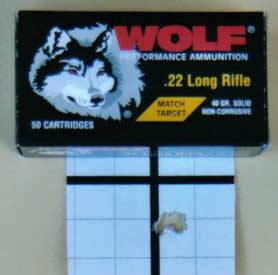
|
|
"Wolf Match Target
gave the best performance at the lowest cost." |
|
I then set up a target at 50 yards. The more expensive Match Extra
produced a very good group of .253 inches - just a bit over a quarter of an
inch. Very nice indeed! The inexpensive Match Target then produced a group
approximately half that of its big brotherís i.e. .174 inches!! How could this
be? Never the less, there it was. Just when you start to think you know
something about 22 ammo, you get kicked in the teeth by something like this. The
only thing I can think of that might explain the superior performance of a
cartridge with a fairly wide variation in bullet weight is the powder. That disk
powder just might be a better type than the extruded stuff used in Match Extra.
However, thereís no way for a consumer to solve that riddle.
|
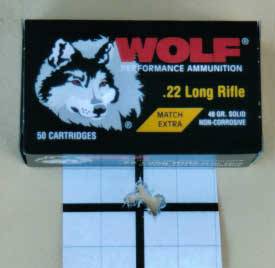
|
|
"Wolf Match Extra
provided high quality control and good grouping ability." |
|
Bottom line. As you know 22 firearms are very cranky about what ammo
they like. Try a box of both types in your guns. You might get lucky like I did
and have the cheap stuff shoot the best.
Some New Cartridges
2004 is bringing at least two new cartridges to the shooting scene. The first
is the 204 Ruger. A joint effort by Ruger and Hornady, this is essentially a 222
Mag case necked down to 20 caliber. (The 222 Mag is approximately 5% larger than
the 223.) It uses a 32 grain Hornady V-Max type bullet that when loaded to
factory specs will develop over 4200 fps. That beats even the 220 Swift in raw
velocity.
The cartridge is designed primarily to out shoot
the 22-250, which has long been the darling of varmint hunters. Besides itís
obvious velocity superiority, the advantage of the new cartridge is that because
it uses less powder and a lighter bullet, recoil is correspondingly reduced. Additionally, any action that can accommodate a 223 class case can also
handle the new 204.
|

|
|
"The 204 Ruger by Hornady is
engineered to outshoot the 22-250." |
|
I also have it on good authority that Thompson
Center will be churning out barrels for both the Encore and the G2 Contender in
15 and 26 inch lengths for the 204.
Iíve already received some calls and e-mails asking if I thought this
new case could be used as a basis for a silhouette cartridge. Sure it could, but
it wouldnít have any real significant advantage over a standard 223 or 222 Mag
case. An unaltered 204 probably could be used for half scale, but I suspect itíd
be kind of rough on the targets.
The other new cartridge announcement comes from Remington. In a much
lower key, Remington revealed the 6.8 Remington SPC. By the way 6.8 = 270
caliber. (Why donít they just say 270?)
Additionally SPC stands for "Special Purpose Cartridge". This was a
joint development with the U.S. military, so Iím sure that "Special Purpose"
really means "sniper".
The new cartridge is based on the old, obsolete 30
Remington. If youíre of a certain age, or a cartridge buff, youíll know that the
30 Remington is a rimless version of the 30-30.
It was basically made to work in a Remington semi auto rifle and a
slide action rifle of the period. Performance of the cartridge was identical to
the standard 30-30.The new cartridge uses a 115 grain Sierra MatchKing bullet
that will being going around 2800 fps. A Remington boat tail hollow point and a
full metal jacket will be available as well. The cartridge is designed to work
in M-16 rifles and be accurate and effective out to 500 meters.
Again, the question will arise as to whether it can be used as a basis
for a silhouette cartridge. Yes, but thereís a catch. The case head on a 30
Remington is not a standard size and so any gun chambered for it will need a
appropriately sized bolt head. But as they say, money can just about solve any
problem if youíre willing to spend it.
New Burris Spotter
Got an announcement for a new version of Burrisís 50 mm Landmark
Compact spotting scope. The standard model comes with a 20X lens. The new model
sports a 12 X 24 variable eyepiece. I have to admit that I like compact
spotters. Even for range work, theyíre very easy to cart around and use. If
youíre going into the field, dragging an 80 mm around is totally out of the
question. I especially like the fact the new spotterís variable goes down to 12
power. Most scopes are grossly overpowered. In other words, their magnification
capability goes way beyond the ability of the human eye to actually use. 12 to
24 powder strikes me as an ideal range, especially for a 50 mm objective.
These scopes come with all of the nice to haves i.e. fully multicoated
lenses, water proof, and fog proof. The price wonít blow up your wallet, your
check book, and your IRA either.
Reloading Favorites
One of the guys brought a copy of one of the slick paper shooting
magazines to the range the other day. During a line break, I picked it up off
his bench and just flipped through it casually. One of the articles was entitled
"Reloading Equipment I Couldnít Do Without" or something like that. I didnít
read the article but it got me thinking about what reloading stuff I really use
a lot. Hereís a list of my favorite things.
RCBS JR. Reloading Press
- I bought this thing back in the late 70ís and it has served me faithfully
without a hitch for all that time. I believe it may be actually indestructible.
Itís a real shame that theyíre no longer made. When buying a press, match your
needs to the product. In other words, if you reload for the big, over sized type
cartridges, then of course buy a big press. On the other hand, if you reload
primarily for smaller cartridges up to 30-06 in size, save some money because
one of the high quality smaller presses will be much easier to use and will
still last a lifetime.
RCBS Digital Loading Scale - Not sure how old it is but I got one of
these as a Christmas present just after RCBS put them on the market. Again,
never a problem with it. While digital scales are no more accurate than a
balance beam type, boy are they convenient and fast. Iíve weighed everything
from primers, powder, cases, bullets (cast & jacketed), gas checks, and 22 ammo
on that thing and it still keeps on ticking. Love it.
|
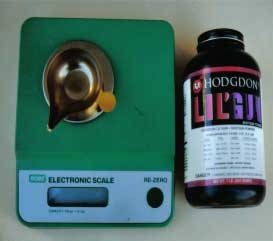
|
|
"The RCBS digital
scale has proven to be very reliable, fast, and accurate." |
|
Redding Competition Seating Die - revolver reloading doesnít get
serious attention from most shooters and yet it is the most demanding of any of
the reloading disciplines other than perhaps benchrest. To squeeze the most
accuracy from a firearm that has between five and six separate chambers and
requires the bullet to jump across an air gap into the barrel, every reloading
trick in the trade needs to be utilized. A lot of people use special seating
dies for their bottlenecked cartridges in their single shot firearms. They
should do the same for their revolvers. The die insures that bullet and case are
as aligned with each other as mechanically practical to ensure the bullet is
seated straight. A must have.
|
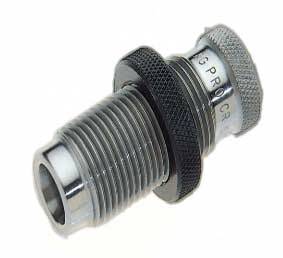
|
|
"The Redding profile
crimping die is a must have for any revolver competitor." |
|
Redding Profile Crimp Die - This uses two types of crimp to make sure
a bullet wonít move in the case when a revolver is in recoil. If the case has
been used several times, the brass at the mouth is probably getting weak and the
crimp is not as effective as when new. The result can be bigger groups or
sometimes if a case is very well used, even a flier. This is the best crimping
die there is.
|
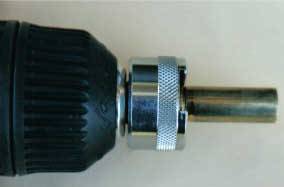
|
|
"Sinclair International Case Spinner - This simple tool is the
fastest way to clean brass" |
|
Sinclair International Case Spinner - this is basically a spindle that
I chuck into a portable electric drill with a shell holder on the end. Put the
case in the holder, tighten it down, and rev her up. Take a wad of 0000 steel
wool and hold it around the case to clean it up in a flash. Works really well on
filthy revolver cases used with cast bullets. To make cases shine like new, use
a wad of "Never Dull" instead of steel wool.
Oehler Dual Channel Chronograph - while not strictly a reloading tool,
this instrument will show me whether the care and attention to detail Iíve given
to my reloading efforts have paid off in practical terms. If I know the velocity
of a load, I can calculate momentum/knockdown. A standard deviation number will
indicate differences in bullet drop for us at 200m from one shot to another. A
big jump or even a drop in velocity when adding powder to a previous load is a
serious indicator of dangerous pressure even when the appearance of the primer
seems ok. There are all kinds of things that a good chrono can do for us.
However, the numbers from a chronograph will not tell you how accurate a load
will be. Only bench testing can do that and donít let anyone tell you different.
The Oehler machine is more expensive than other chronographs but the quality is
very, very good. The thing that really makes it stand out though is the customer
service. Just outstanding. Iíve dealt with others, and they donít come close.
While I use lots of other things when I reload, these are the things
that I seem to use the most because they work, theyíre extremely reliable, and
as mentioned, customer support is superb.
![]()